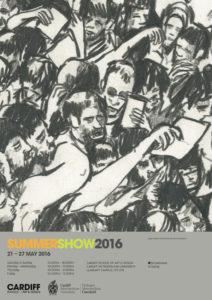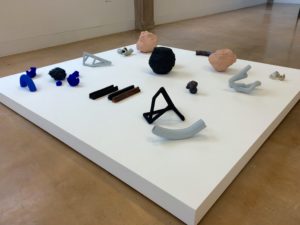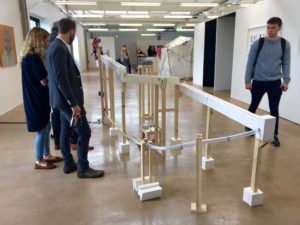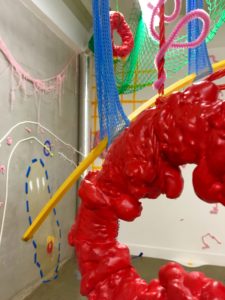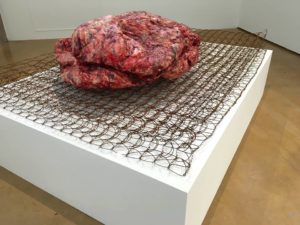Universities all over the UK are currently opening their doors to the public to celebrate the occasion where soon-to-be Fine Art Graduates show the culmination of their three years of study.
Having been previously caught-up arranging my own final exhibition at Loughborough University, I am more than pleased to be offered the chance to explore the Undergraduate Degree Show at Cardiff School of Art & Design 2016.
On entry to the building, I am reminded of one of the reasons I elected to study at CSAD in the first place. Ascending the stairs into the appropriately-named Heart-Space, the invited guests attending Industry Night are treated to a drink at the bar whilst they anticipate the exhibition spaces above. The space is at once open and inviting.
On the third floor, what were formerly studios are now transformed into polished exhibition space. At this stage I’d typically offer an introduction to my first impressions of the general aesthetic, or approach-to-making of the Cardiff show, but there isn’t one. As Olwen Moseley, Dean of the School of the Arts, states in her address, Cardiff’s Arts Undergraduates are really given the choice to apply whatever creative medium that takes their fancy; meaning the university encourages students to adopt a cross-disciplinary approach to the nature of their learning and practice.
Subjects including The Overlooked are addressed by artists Sophie Burrows and Megan Fergusson; Scale is explored, from examples of miniature maquettes to the monumental nature of Ethan Dodd’s crystallised representation of a lightning bolt. A Sense of Home was another concept addressed by Mary Walter-Thomas in ‘Eirianell’, as well as in the works of Megan Fergusson and Zoe Peridakis. The Self and Consciousness are explored in the work of Jade Trollope and Tobiasz Wasyliszyn.
Creative approaches concerned with the Materiality of objects is a topic frequently addressed by the works exhibited at Undergraduate Degree Shows, however, with one of the foremost Ceramics courses in the UK, at Cardiff School of Art & Design, Materiality is done well. One such artist approaching the theme was Nathan Mullis, whose works address how the making process can afford the objects meaning and significance.
Further diversifying the nature of display, the Fine Art show includes a darkened exhibition space as well as the typical white-cube environment, showing digital video-works and light-works.
Despite recognising some links in the subjects of the works exhibited, every student has accomplished a distinctive approach. The section below details my picks of works included in the Summer Show that showcase the talents of the soon-to-be recent Graduates of CSAD:
Emily Panizzi’s contribution to the show, an operational marble-run construction, functions as a metaphor for current financial structure and practice. The work is designed to represent economical cash-flows and trickle-down economies, highlighting the eventuality of most currency settling in the pockets of the wealthiest 1%.
Panizzi has expressed an interest in the Japanese concept of Ma, which “explores ideas around a space delivering an experience”, and it is the interactive aspect of the work that I consider most successful. Whether deliberate or not, occasional system failures -where a marble might stick in the works, or leave the run altogether- serve to support the metaphorical functioning of the piece.
Lauren Bailey’s abstract micro-compositions appear to populate, or even germinate within their pocket of space inside the CSAD building.
Jovially gathering in this cohesive installation work, the constituent parts of Bailey’s artwork make up a virus of two and three-dimensional things that might threaten to infect the shared exhibition space had they not been contained.
Bailey’s installation incorporates features of the physical environment, growing over foil-covered vents and galvanised pipes. Seemingly improvised forms constitute the ‘real-world’ expression of marks made by digital drawing tools, and the viewer is transported into a three-dimensional drawing of a soft-play centre.
Through playful combination of colour and form, this light-hearted approach to process and materials reads as an ode to the doodle and relieves the viewer from the often-weighty nature of contemporary artworks.
There is joy in the simplicity of Bailey’s compositions.
www.laurenbaileyart.tumblr.com
Danielle Adair’s contribution to the show appears, on first impressions, both repulsive and intriguing. Atop the rusted and bare innards of a sprung mattress, sits an abject representation of…what exactly? Certainly something of the once internal, made external is at work here. Initially communicated is a callous harshness, an image devoid of comfort. Adair’s Phil questions tensions between the physical and psychological conditions of the body. The pulsing mass of exposed flesh is, to me, a reminder of the incarceration of the psyche within the abject body. The mass of injured latex and rattling motor translates as a physical embodiment of the inevitability of suffering. As in David Lynch’s Eraserhead, the ‘child’ is exposed as skinless and sore, Adair’s Phil is itself an example of a raw, unsettling presence, an acceptance of the limits of the flesh. However gruesome, perhaps Phil has the opposite capacity; to communicate a certain optimism, or triumph of consciousness over the flesh.
Julia Hopkins presents a playground of perplexing, small-scale structures, (or are they maquettes of larger works?) Hopkins’ constructions dance the boundary between the functional and non-functional; what should be, and what is. These are structures that appear initially to have a purpose, or function, but on further inspection reveal a uselessness which implies that the value of the objects must lie elsewhere.
Akin to a contemporary-art-MouseTrap, the neo-modernist compositions imply interconnected movement, balance and reactivity. Recognisable in the works is a strong synergy of materials; common threads: timber, plaster, thread itself. Also recognisable are a host of recurrant symbols; the pendant, the tower, the scaffold…but why? Everything about this collection of works suggests a game of sorts, to make sense of the arrangement where perhaps the joke is that there is none. Hopkins perpetuates a state of curiosity, a need to ‘figure-it-out’, where so-often artworks convey strictly determined readings. Thank you for keeping us on our toes.
An ominous mountain of refuse dominates the exhibition space of Sam Wall. It mechanically stutters and screeches towards viewers who might draw closer to investigate.
This awkward stack of regurgitated detritus has been collected by the artist from the urban environment. Objects, or leftovers, spat out by the city and rendered purposeless are collected and absorbed into a creature befitting the grim-reaper of throw-away tat.
Wall’s monster-making, in both his sculptural and two-dimensional works, questions the value of objects to represent a culture deemed obsolete.
https://www.facebook.com/ekstraternek/
I would like to join Olwen Moseley in wishing this year’s graduates all the best in their futures, be that in pursuing further study or employment in industry. I fully recommend readers to pay a visit to the Fine Art Degree Show 2016, and to check out equally impressive offerings by other departments of the school while you’re there!
Cardiff School of Art & Design’s Degree Show 2016 runs on the Llandaf Campus from 21st – 27th May.
https://www.cardiffmet.ac.uk/artanddesign/Pages/summer-show.aspx

